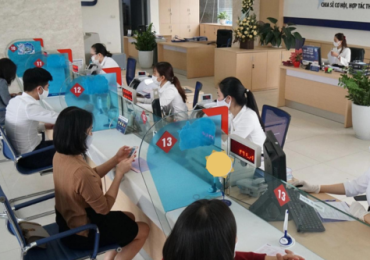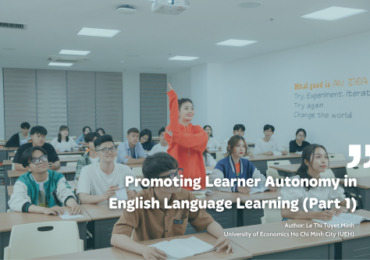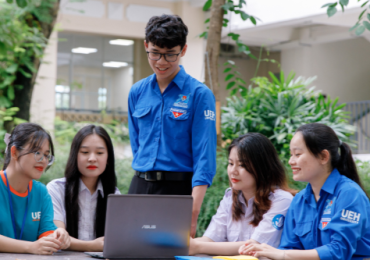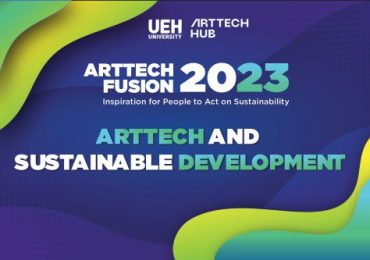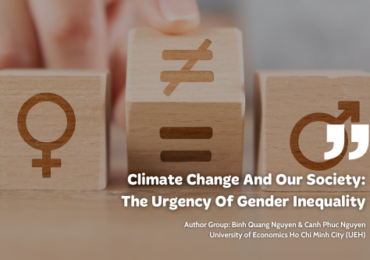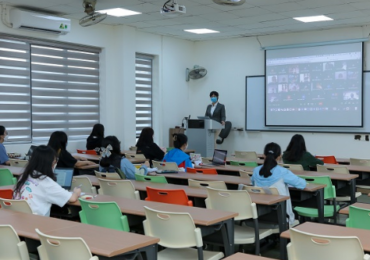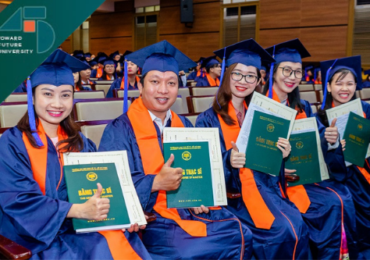Motivation of EFL Vietnamese Students in Economics-related Majors
12 October, 2023
Motivation plays an essential part in learning, especially in second language acquisition (SLA). What drives UEH students to learn English and are there any differences between first- and second-year students’ motivation? This paper investigates the learning motivation of Vietnamese economics-related majors studying English as a Foreign Language (EFL), utilizing Dornyei’s (2005) L2 motivational self-system as the theoretical framework. The study endeavors to provide a comprehensive review on students’ motivation to learn English. The Ideal L2 Self, Ought-to L2 Self, the students’ attitudes together with their efforts in English learning were investigated, and key motivational factors, i.e. the roles of teachers, peers, school and parents, were identified. This research provides some insights into the students’ motivation and offers recommendations for enhancing the motivation of EFL learners in a Vietnamese tertiary context.

Motivation in SLA
Motivation is one of the key factors that influence the success of language learning. Gardner (1985) defines language learning motivation as “the extent to which the individual works or strives to learn the language because of a desire to do so and the satisfaction experienced in this activity” (p.10). Rost (2006) defines motivation as an orientation toward a goal. Motivation provides a source of energy which is responsible for why learners decide to make an effort, how long they are willing to sustain an activity, how hard they are going to pursue it, and how connected they feel to the activity. Lumsden (1994) states that student motivation is students’ desire to participate in learning. In this study, students’ efforts to learn the target language are considered to be motivation and it plays an important role in learning English.
The L2 Motivational Self System (L2MSS)
According to Dörnyei (2005, 2009) the L2MSS consists of three main components: the ideal L2 Self, the ought-to L2 Self, and the L2 learning experience. The ideal L2 Self refers to the state one would ideally like to reach, thus representing one’s own hopes, aspirations, and goals in learning the L2. The ought-to L2 Self, on the other hand, represents the L2 learner’s perceived duties, obligations and responsibilities in learning the L2. On a different aspect, the L2 learning experience is associated with the L2 learner’s experience from one’s failures and successes in learning the L2 in the past and the immediate learning environment; and is influenced by situation-specific aspects such as the teacher, the curriculum, and peers. As stated by Dörnyei (2005, 2009), students’ attitudes regarding their learning illustrate the L2 learning experience and the L2MSS.
The L2MSS has been widely used as the theoretical framework for over 400 publications around the world and validated in a range of EFL contexts in different countries such as Chile, Hungary, Saudi Arabia, China, Japan, Indonesia, Pakistan, and Iran in various studies of Al-Shehri (2009), Csizér&Kormos (2009), Papi (2010), Ryan (2009), Taguchi et al. (2009), etc.
Objectives & Research questions
The research aims to:
- compare the motivational self-system for learning English (Ideal L2 Self, Ought-to L2 Self, and L2 learning attitudes) between first-year and second-year students.
- compare the levels of effort to learn English between the two groups.
- investigate the correlations between students’ effort and the three dimensions of the motivational self-system.
- propose some implications for the stakeholders to enhance students’ motivation to learn English.
The research attempts to give a comparison of the first-year and second-year students’ motivation in order to determine if there are any differences in students’ motivation after one year of studying in a tertiary environment.
The following research questions guide the study:
RQ1: Are there any differences in the L2 motivational self-system (Ideal L2 Self, Ought-to L2 Self, and L2 learning attitudes) between the first-year and second-year students?
RQ2: Are there any differences in the effort to learn English between the two groups?
RQ3: Are there any correlations between the students’ effort and the three dimensions in the motivational self-system (Ideal L2 Self, Ought-to L2 Self, and L2 learning attitudes)?
RQ4: What do students expect the stakeholders to do in order to promote their motivation to learn English?
Research instruments
To collect the data for the study, a questionnaire was designed in Google form and included 5 parts: 1. Demographic information; 2. Motivation for learning English; 3. Attitudes; 4. Effort; 5. Factors affecting motivation to learn English. The demographic part includes information on gender, age, English module, and majors. Parts 2 to 4 consist of 24 items taken from Dörnyei’s (2005, 2009) questionnaire, which investigate four dimensions: the Ideal L2 Self, the Ought-to L2 Self, attitudes, and effort. Each dimension is evaluated with a 6 six-point Likert scale. To avoid the misunderstanding of the L2, the questionnaire was translated into Vietnamese.
An open-ended section is added with ten questions to probe further into the students’ motivational orientations, influencing factors such as teachers, friends, administrators, community, learning materials, and facilities, and their expectations for the stakeholders.
The focus group interview with nine questions to triangle and delve deeper into the results of the questionnaire.
Convenience sampling was used. The items were coded as follows: the Ideal L2 Self (items1-6) as I1-6, the Ought-to L2 Self (items 7-12) as O1-6, learning attitudes (items 13-18) as A1-6, and students’ effort (items 19-24) as E1-6.
Results and discussion
250 first-year students and 101 second-year students agreed to join the survey and responded to the survey. However, datasets were screened for outliers. The first-year and second-year students’ responses, totaling 236 and 99 respectively, were analyzed. Because there was quite a limited number of Module 4 English classes, the number of second-year respondents was modest. The participants in both groups come from all 14 departments at one University of Economics in Ho Chi Minh City, Vietnam including Accounting, Maths – Statistics, Business Information Technology, Law, State Management, Tourism, Economics, Administration, International Business – Marketing, Finance, Public Finance, and Banking.
RQ1: Are there any differences in the L2 motivational self-system (Ideal L2 Self, Ought-to L2 Self, and learning attitudes) between the first-year and second-year students?
Table 1. Comparison of Ideal L2 Self between the First-Year (G1) and Second-Year (G2) Students
| G1 (No=236) | G2 (No=99) | t | Sig. | |||
| Mean | S.D | Mean | S.D | |||
| I1 | 5.40 | .910 | 5.30 | 1.102 | .740 | .461 |
| I2 | 5.11 | .942 | 5.01 | 1.129 | .873 | .385 |
| I3 | 4.33 | 1.045 | 4.18 | 1.265 | 1.347 | .181 |
| I4 | 4.40 | 1.204 | 4.31 | 1.345 | 1.007 | .316 |
| I5 | 5.10 | .971 | 5.06 | 1.028 | 1.216 | .181 |
| I6 | 5.21 | 1.021 | 5.18 | .952 | .295 | .769 |
| Overall | 4.93 | .836 | 4.84 | .886 | 1.167 | .246 |
The data in Table 1 reveal that both groups of students claimed to have an Ideal L2 motivational self with M=4.93 and M=4.84 respectively over the six-point scale. When comparing the mean scores of the two groups, it is found that there is no significant difference (sig.>0.05).
Table 2 below shows the comparison of Ought-to-L2 Self between the first-year and second-year students.
Table 2. Comparison of Ought-to L2 Self between the First-Year (G1) and Second-Year (G2) Students
| G1 (No=236) | G2 (No=99) | t | Sig. | |||
| Mean | S.D | Mean | S.D | |||
| O1 | 4.10 | 1.382 | 4.11 | 1.332 | .985 | .327 |
| O2 | 4.04 | 1.371 | 4.00 | 1.436 | .840 | .403 |
| O3 | 4.51 | 1.306 | 4.59 | 1.309 | .785 | .434 |
| O4 | 4.71 | 1.218 | 4.55 | 1.452 | 1.687 | .095 |
| O5 | 4.83 | 1.054 | 4.84 | 1.175 | .478 | .634 |
| O6 | 5.16 | 1.048 | 5.06 | 1.268 | 1.065 | .289 |
| Overall | 4.56 | .9122 | 4.52 | 1.036 | 1.341 | .183 |
The mean scores presented in Table 2 show that both groups of students did not have a very high level of Ought-to L2 Self with M=4.56 and M=4.52 respectively over the 6-point scale. The comparison of the mean scores of the two groups also indicates that there was no significant difference (sig.>0.05).
The findings of learning attitudes of the two groups are presented in Table 3 below.
Table 3. Comparison of learning attitudes between the First-Year (G1) and Second-Year (G2) Students
| G1 (No=236) | G2 (No=99) | t | Sig. | |||
| Mean | S.D | Mean | S.D | |||
| A1 | 4.70 | 1.129 | 4.62 | 1.057 | 1.270 | .207 |
| A2 | 4.46 | 1.225 | 4.71 | 1.042 | -1.086 | .280 |
| A3 | 4.71 | 1.120 | 4.91 | 1.011 | -.794 | .429 |
| A4 | 4.40 | 1.168 | 4.52 | 1.119 | -.127 | .899 |
| A5 | 3.99 | 1.368 | 4.20 | 1.325 | -.802 | .425 |
| A6 | 4.60 | 1.218 | 4.71 | 1.163 | -.663 | .509 |
| Overall | 4.48 | .981 | 4.70 | .884 | -.481 | .631 |
In terms of the student’s learning experience or their attitudes toward learning English, both groups showed agreement on six items but not a very high level over a scale of six (M=4.48 and M=4.70). In addition, the comparison of the mean scores of both groups also reveals that there was no significant difference between these two groups regarding their learning attitudes (sig.>0.05).
RQ2: Are there any differences in the motivational intensity (effort) to learn English between the two groups?
Both groups were found to have a relatively high level of effort in learning English (level 5 over 6) and no significant difference was found between the two groups.
RQ3: Are there any correlations between the students’ effort and the three dimensions in the motivational Self-system (Ideal L2 Self, Ought-to L2 Self, and L2 learning attitude)?
In terms of correlation, the three variables of the first-year and second-year students’ motivational Self-system are significantly correlated with their motivational intensity with a score of p<0.01. Among the three variables of the motivational Self-system, the L2 learning experience of first-year students (coded as A) and the Ideal L2 Self (coded as I) are seen to be highly correlated with their motivational intensity (r=.613 and r=.488 respectively for the first-year students and r=.585 and r=.613 respectively for the second-year students) and Ought-to L2 Self is claimed to have the lowest correlation with the motivational intensity (r=.264 and r=.344 respectively for the first- and second-year students).
RQ4: The stakeholders’ roles and students’ expectations
Regarding the factors influencing the students’ motivation, 80% of students in both groups acknowledged that their teachers had an impact on their motivation. They emphasized the value of the instructors’ enthusiasm, creative teaching strategies, and an exciting and supporting learning environment. Many students stressed that teachers should inspire students to learn. As a result, the students placed the instructors together with their teaching methods first, followed by social community in the ranking of the elements that have the greatest influence on their motivation. The instructors with their teaching methods were also the aspect that the students (83% and 80%) like the most. The facilities came in second (78% and 70%). Concerning the role of friends, both groups (76% and &77%) agreed that friends had an influence on their motivation due to peer pressure and mutual help. With respect to parents’ assistance, more than half of the students (64% and 58%) stated that their parents support them in learning English by paying their tuition fees, providing good conditions and encouraging them to learn. As far as the role of the university is concerned, both groups (90% and 80%) said that the university supports them well in learning English. They appreciated the university for creating a good environment for them to learn English with modern facilities, good lecturers, specialized documents in English, many English clubs and contests. However, some students voiced concerns regarding some outdated course materials, a mismatch between instructional materials and tests, and some tough lecturers.
The focus group interview results reinforced the aforementioned findings.
Please refer to the full paper “Motivation of EFL Vietnamese Students in Economics-related Majors” HERE.
Author Group: Le Thi Tuyet Minh, Nguyen Huynh Trang – University of Economics Ho Chi Minh City (UEH)
This is an article in the series of articles spreading research and applied knowledge from UEH with the “Research Contribution For All” message, UEH cordially invites dear readers to look forward to the upcoming Knowledge Newsletter ECONOMY No. #89.

News & photos: Author group, UEH Department of Marketing & Communication

